NASA DEVELOP Welcomes Spring 2024 Interns
NCEI News Feed
https://www.ncei.noaa.gov/news/nasa-develop-ncei-spring-2024-term
NCEI is proud to be entering their 10th year of partnership with the NASA DEVELOP Program!
NCEI News Feed
https://www.ncei.noaa.gov/news/nasa-develop-ncei-spring-2024-term
Sitting at 26 miles long and 24 miles wide with nearly one-third of the sport fishing catch annually in the Great Lakes region, Lake St. Clair should be a household name.
Author Daniel Harrison would tell you it's his hidden jewel.
The post An underappreciated lake that’s great first appeared on Great Lakes Echo.Great Lakes Echo
http://greatlakesecho.org/2024/03/20/an-underappreciated-lake-thats-great/
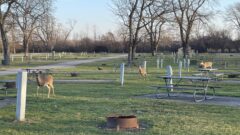
The path of totality during the April 8 solar eclipse is expected to run directly across northwest Ohio, keeping tourism officials in the area, who normally plan for crowds to begin arriving in May, extra busy.
Some private campgrounds in the area that are opening early for the eclipse and have sites available, including Crystal Rock, Erie and Ottawa County fairgrounds, Cedarlane RV Resort, Camp Sandusky and Camp Perry RV Park.
Great Lakes Now
https://www.greatlakesnow.org/2024/03/where-to-see-rare-solar-eclipse-in-ohio/
NOAA Great Lakes Environmental Research Laboratory
NOAA Great Lakes Environmental Research Laboratory
https://noaaglerl.blog/2024/03/19/early-spring-update-on-great-lakes-ice-conditions/

One of the 21 images painted by Art Fleming that line the walls of the Kom-on-Inn in Duluth. This one depicts the U.S. Steel Plant, which has been torn down and is now a Superfund site that is being cleaned up. Note the St. Louis River in the background. The presence of the river emphasizes the role that water has played and continues to play in shaping the city of Duluth. Image credit: Jennifer Webb, University of Minnesota Duluth.
The smell of stale cigarette smoke is the first thing to strike as I walk into the Kom-on-Inn Bar not far from the St. Louis River. Even though indoor smoking in public places was banned 17 years ago in Duluth, Minnesota, the scent lingers here.
It’s 10:30 a.m.; several patrons sit under dim lights at the bar with their beers, chatting. But I’m not here to drink. I’m on a field trip that’s part of the St. Louis River Summit, an annual conference to share information about the largest U.S. tributary that enters Lake Superior on Wisconsin’s northwestern border, and site of the second-largest Area of Concern in the country.
Bars aren’t typical locations for conference field trips. However, this one in West Duluth was chosen for several good reasons. The old paintings that line its walls are one of them. The other reasons involve the bar’s importance to the community.
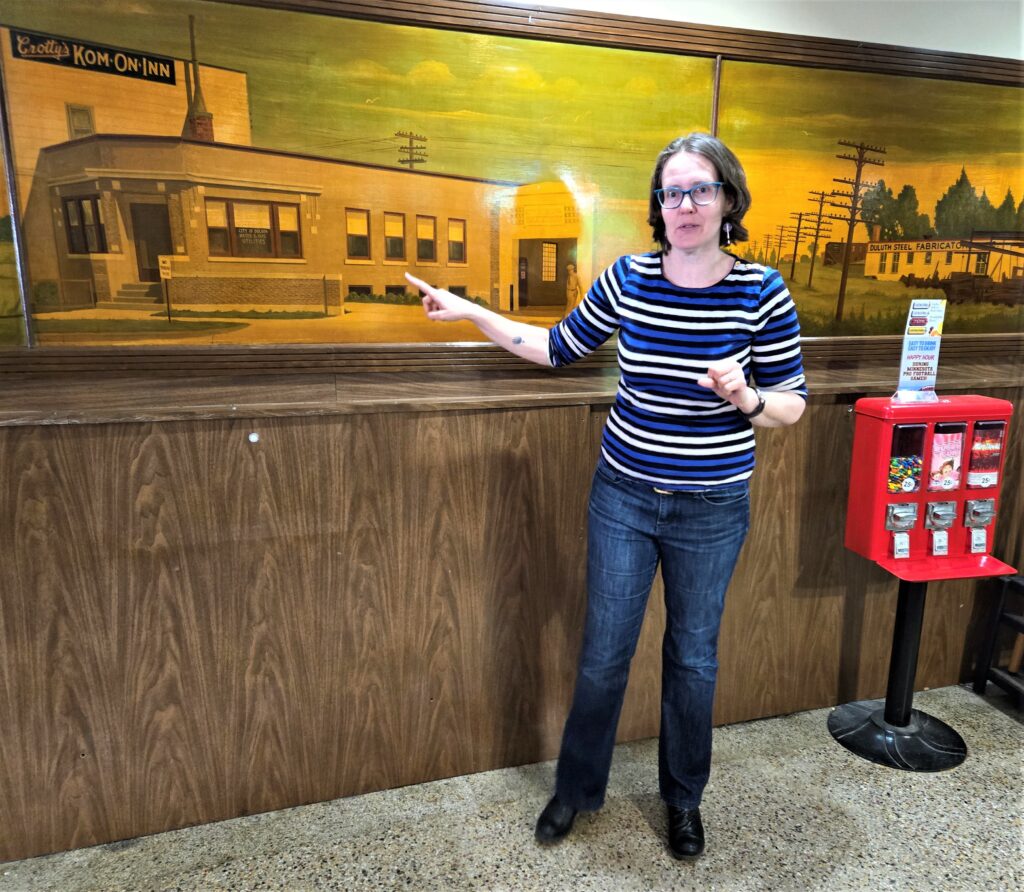
Art Historian Jennifer Webb describes the community significance of architectural portraits that hang in the Kom-on-Inn Bar in West Duluth, Minnesota. Image credit: Marie Zhuikov, Wisconsin Sea Grant
According to field trip host Jennifer Webb, an art historian and head of the Department of Art and Design at the University of Minnesota Duluth (UMD), 21 paintings are displayed on the bar’s walls, with another 20 stored in the basement.
A resident of this area of Duluth, Webb has studied the artworks for several years and has written a scientific journal article about their significance. Created between 1950-51 by Western Duluth resident and sign painter Art Fleming, these architectural portraits depict local businesses where many of the bar patrons worked. There’s the U.S. Steel mill that made barbed wire and pig iron, the Coolerator Co. that made refrigerators and a coal-fired power plant. A blue strand of the St. Louis River flows through almost every image. The paintings’ varnish coating has yellowed with age and sealed in the cigarette smoke scent.
To Webb, the bar and the portraits epitomize the area. “As an outsider who didn’t grow up in a community like this, the first thing that I was struck by is how every neighborhood has a place, an anchor and an identity.” Bars like the Kom-on-Inn provided a place for workers to gather at the end of their shifts to “decompress from a very difficult and hard industrial life,” she said.
Many of the industries in the paintings closed only two decades after their depiction, leaving unemployment and pollution in their wakes. In Webb’s journal article she says the portraits are a “testament to the pride in place and the importance of the river and industries in the making and then breaking of the neighborhoods and the larger ecosystems of which they are a part.”
Webb suspects that Fleming painted the portraits from photographs since many similar scenes can be found in the photo archives at UMD. The artworks were commissioned by the original bar owners, the Crotty Family, and their preservation is a requirement each time the bar changes hands.
Webb divides us into small groups so that we can take a closer look. In front of one portrait of the river neighborhood of Morgan Park, comprised mainly of homes built by U.S. Steel Co. for their workers, Webb describes the experience she had interviewing people about this painting and their nostalgia for the way of life it depicts.

The Kom-on-Inn panel painted by Art Fleming, located inside the bar. Image credit: Jennifer Webb, University of Minnesota Duluth.
“People who grew up there, when they talk to me about it, they remember their childhood fondly. They had a perfect community. They never really needed to leave. The doctor was there, the dentist. They had a fire department and a hospital,” Webb said. Many of those services are no longer offered directly in Morgan Park.
Plans for remediating Areas of Concern stress the importance of placemaking, which is the process of using public input to create quality places where people will want to live, and broadening the definition of stakeholders. In her paper, Webb argues that such stakeholder groups should include local historians, archivists and art or architectural historians who can offer insights into the built and visual landscape. She also contends that the most successful community revitalization and placemaking work need not create new places but instead should focus on remaking places already formed and to which community members are attached.
“Duluth is so well situated to build walkable communities. We’ve got these anchors like the Kom-on-Inn that were already built as our communities strung themselves out along the waterways. I can’t wait to see where we’re going,” Webb said of restoration efforts.
I left with a new appreciation for this neighborhood where I went to high school, and a broader understanding of the connections between the St. Louis River, its recovery and some paintings in a neighborhood bar.
If you’d like to see the paintings and can’t travel to Duluth, watch this recent television news story about them.
The post A conference field trip to a bar links river and art to community first appeared on Wisconsin Sea Grant.Blog | Wisconsin Sea Grant
https://www.seagrant.wisc.edu/blog/a-conference-field-trip-to-a-bar-links-river-and-art-to-community/
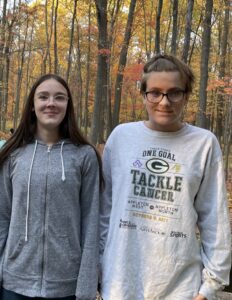
Emma and Rory spend time outside with their troop.
It’s not just about the cookies.
Girl Scout troops 2278 and 2378 have been working together to care for our watershed for years. No one can remember quite when they started, but they remember the badge they were working on.
Troop leader Julie Schubring explained that some badges are part of a series called a Journey. The Brownies in the troop were working on their Wonders of Water journey and needed a service project to connect them with water. For their final task, the Fox-Wolf Watershed Cleanup was a perfect fit.
“They all love water things,” Julie said. “We go kayaking, hiking to waterfalls, swimming.” So it wasn’t hard to get them interested in keeping their water clean.
Those same Brownies are now middle and high school students, some of whom are still invested in caring for our local waters. But their understanding of water quality has grown beyond just picking up trash.
“Some of the older kids have gone to the water plant and learned about how water is managed,” Julie said. The scouts wanted to learn how to help with water quality before it even gets to the treatment plant.
It would be easy for these kids to get their badges, complete their Journey, and move on to something else. Instead, they keep volunteering, year after year.
“They’re so excited to participate,” Julie shared. “They want to find new things, but their hope really is to find that there is hardly anything there to clean.”
In the past, this troop has found a wide variety of items to pick up.
“People throw away a lot of cans and wrappers,” said Rory, age 16. “And fishing line is annoying to clean up. It gets tangled in the trees.”
Emma added that they’ve seen big things too, like tires and even a whole muffler!
Because they’ve been participating for a couple of years, Emma and Rory have watched the trash at their local site come and go.
“Because our site is local to us, we get to go back and see it other times of the year,” said Julie. The troop has other events at the park, and the scouts have other family or community reasons to be there as well.
“It makes me happy to know I can help. But I also get annoyed and angry that it doesn’t stay clean,” said Rory. Emma agreed and added, “It’s sad that trash in my town is this big of a problem.”
Undaunted, these two scouts and the rest of their troop have been returning to the cleanup year after year. And they’re inviting family members to join them. “I went the first time because I was supposed to, but I ended up enjoying it, so I keep coming back,” said Emma.
Emma has managed to convince her siblings, her mom, and her grandma to join in. What’s the secret for being persuasive? “I just ask nicely!”
Join us on Saturday, May 4, 2024
The annual Fox-Wolf Watershed Cleanup takes place every year on the first Saturday of May. This event brings over 1,600 volunteers to over 60 sites across our watershed. Thanks to their efforts, thousands of pounds of trash are removed from the shores of our waters every year.
Watershed Moments is a publication of Fox-Wolf Watershed Alliance, sharing the stories of how your donations have impacted lives in our community. Read our latest project updates, make a secure online donation, or become a member at www.fwwa.org
The post Watershed Moments: Year After Year appeared first on Fox-Wolf Watershed Alliance.
Fox-Wolf Watershed Alliance
https://fwwa.org/2024/03/19/watershed-moments-year-after-year/?utm_source=rss&utm_medium=rss&utm_campaign=watershed-moments-year-after-year
Precision agriculture technology has been evolving over the past decades, and farming has become more productive and efficient with the further implementation of artificial intelligence.
A 2023 study by the U.S. Department of Agriculture found only 27% of farms and ranches nationally used such precision agriculture practices, but the rate was around 40% in Michigan.
The post High tech, AI, boost farm productivity, earnings first appeared on Great Lakes Echo.Great Lakes Echo
http://greatlakesecho.org/2024/03/19/high-tech-ai-boost-farm-productivity-earnings/
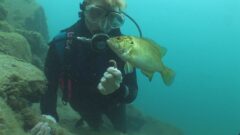
I Speak for the Fish is a monthly column written by Great Lakes Now Contributor Kathy Johnson, coming out the third Monday of each month. Publishing the author’s views and assertions does not represent endorsement by Great Lakes Now or Detroit Public Television.
Great Lakes Now
https://www.greatlakesnow.org/2024/03/i-speak-for-the-fish-when-a-bass-is-not-a-bass/

By Jena Brooker, BridgeDetroit
BridgeDetroit reporter Jena Brooker collaborated with One Detroit (Detroit Public TV) on this segment on concrete crushing in a Detroit neighborhood. Read more of her coverage and subscribe to her newsletter.
One Detroit’s senior producer Bill Kubota teamed up with filmmaker and One Detroit contributor Nicole Macdonald to talk with residents about their concerns over heavy industry operating in city neighborhoods.
Great Lakes Now
https://www.greatlakesnow.org/2024/03/video-its-detroiters-vs-dust-in-west-side-neighborhood/
U.S. federal wildlife regulators have a coming deadline in June to decide whether lake sturgeon should be protected under the Endangered Species Act. The collective concern is whether and even how a change in federal protections could alter existing fishery efforts and both angling and spearing seasons for sports fishers. Read the full story by MLive.
Great Lakes Commission
https://www.glc.org/dailynews/20240318-sturgeon-protections
Water levels across the Great Lakes are projected to drop below last year’s levels over the next six months during Michigan’s peak boating season, according to the latest forecast by the U.S. Army Corps of Engineers. Read the full story by The Detroit News.
Great Lakes Commission
https://www.glc.org/dailynews/20240318-water-levels
In response to a bill proposed in the New York State Senate, advocates want New York Governor Hochul to support a moratorium on any Great Lakes wind turbine development. The bill would allow the New York State Energy Research and Development Authority to issue licenses to wind developers looking to build in Lake Erie or Lake Ontario. Read the full story by WGRZ-TV – Buffalo, NY.
Great Lakes Commission
https://www.glc.org/dailynews/20240318-turbine-moratorium
As temperatures rise and the lakes unfreeze, the National Oceanic and Atmospheric Administration (NOAA) will begin researching the Great Lakes’ acidity levels, providing ships and space for U.S. Department of Defense research, and collaborating on a study of Lake Huron sinkhole microbial communities. Read the full story by The Alpena News.
Great Lakes Commission
https://www.glc.org/dailynews/20240318-noaa-research
New Ohio Sea Grant research measured veterinary antibiotics in Lake Erie tributaries and found that some medications are prevalent in regional watersheds at low concentrations. The team also confirmed that across watersheds, antibiotic levels were associated with the density of livestock nearby. Read the full story by The Crescent-News.
Great Lakes Commission
https://www.glc.org/dailynews/20240318-erie-antibiotics
Hundreds of dead fish and other creatures were found washed up on Montreal’s South Shore along the St. Lawrence River. The die-offs are being investigated and could be due to recent low water levels or the warm winter weather. Read the full story by the CBC.
Great Lakes Commission
https://www.glc.org/dailynews/20240318-montreal-fish
The Great Lakes region has a lower risk of extreme weather compared to other parts of the country and is referred to as a “climate haven.” But before it can be considered as such, researchers emphasize the importance of urban planning and addressing social and environmental challenges that Great Lakes cities have. Read the full story by Great Lakes Echo.
Great Lakes Commission
https://www.glc.org/dailynews/20240318-climate-migrants
Around the end of April, the Cleveland Water Alliance will be deploying two ‘smart’ buoys in Erie County, Ohio, to monitor water information in both Sandusky Bay and a Lake Erie tributary. There have been 13 smart buoys in operation so far; a 14th will be added this year, and a 15th will be added this year or next year. Read the full story by The Courier.
Great Lakes Commission
https://www.glc.org/dailynews/20240318-smart-buoys
The Cuyahoga, the oldest Canadian lake boat still in operation, and one year shy of the oldest boat on the Great Lakes, caught fire on Friday. The ship’s master and crew were accounted for. Read the full story by the CBC.
Great Lakes Commission
https://www.glc.org/dailynews/20240318-cuyahoga-fire
The Bad River Band of Lake Superior Chippewas has been fighting for decades to save the Great Lakes from a potential oil pipeline rupture. The new documentary Bad River takes viewers into that ongoing fight against Enbridge’s Line 5 pipeline. Read the full story by WBBM-TV – Chicago, IL.
Great Lakes Commission
https://www.glc.org/dailynews/20240318-bad-river
A California woman on “The Daily Show” recently swapped her sandals for snowshoes after moving to Duluth to escape her state’s wildfires.
The Comedy Central show featured Duluth as a climate haven, an ideal place to live to avoid wildfires, droughts, hurricanes and extreme flooding.
The post Are Great Lakes cities ready for climate migrants? first appeared on Great Lakes Echo.Great Lakes Echo
http://greatlakesecho.org/2024/03/18/are-great-lakes-cities-ready-for-climate-migrants/
Current watches, warnings, and advisories for Brown County (WIC009) WI
Current watches, warnings, and advisories for Brown County (WIC009) WI
https://api.weather.gov/alerts/urn:oid:2.49.0.1.840.0.e30855857b9c7ce0100c0328bc5cb0d9ff48050b.001.1.cap
Ten Great Lakes Echo reporters recently scored honors in the 2023 Michigan Press Association’s College Better Newspaper Contest.
They were recognized in nine categories. The environmental publication swept two categories - feature story and column-review - and won the open categories for best writer and best multi-media story.
The post Michigan Press Association honors Echo reporters first appeared on Great Lakes Echo.Great Lakes Echo
http://greatlakesecho.org/2024/03/15/great-lakes-echo-reporters-honored-with-michigan-press-association-awards/

By Morgan Springer, Interlochen Public Radio
Points North is a biweekly podcast about the land, water and inhabitants of the Great Lakes. This episode was shared here with permission from Interlochen Public Radio.
Nick Baumgartner went to the 2022 Winter Olympics ready to win.
Great Lakes Now
https://www.greatlakesnow.org/2024/03/points-north-olympic-dream-takes-a-u-p-village/
A federal judge has found the city of Flint, Michigan, in contempt after years of delays to replace lead service lines at tens of thousands of homes. Lead line replacement efforts were supposed to be done in 2020, but have dragged on, leaving many residents with cratered yards and broken sidewalks from previous pipe replacement. Read the full story by Bridge Michigan.
Great Lakes Commission
https://www.glc.org/dailynews/20240315-flint-lead
The Line 5 oil pipeline has become a household name in the Great Lakes region, creating intense concern over its potential risk to water quality and its infringement on tribal rights. Summarized are its history, its controversies, and its legal battles. Read the full story by the Milwaukee Journal Sentinel.
Great Lakes Commission
https://www.glc.org/dailynews/20240315-line5-issues
After more than three years of legal delays, work will begin this spring on the long-planned construction of an experimental fish passage system in Traverse City, Michigan. FishPass construction will take until 2026 to complete and will also include a new research facility and improvements to the surrounding parkland. Read the full story by the Traverse City Ticker.
Great Lakes Commission
https://www.glc.org/dailynews/20240315-fishpass-construction
Lake Michigan’s food web has been impacted by overfishing and invasive species. Now, climate change is flexing its muscles in the Lake Michigan ecosystem, impacting lake turnover, plankton, and fish. Read the full story by WUWM – Milwaukee, WI.
Great Lakes Commission
https://www.glc.org/dailynews/20240315-food-web
Last week, a divided Wisconsin Court of Appeals upheld a lower court ruling that limited the Wisconsin Department of Natural Resources’ ability to regulate PFAS and other emerging contaminants under the state’s long-standing spills law. The case is one of two efforts to weaken the spills law. Read the full story by Wisconsin Watch.
Great Lakes Commission
https://www.glc.org/dailynews/20240315-pfas-regulation
As the Berrien County, Michigan, government continues working through an emergency request to help dredge a portion of the St. Joseph River, one of the factors in play is what to do about the fish. There’s a narrow window between now and mid-May — the start of sturgeon spawning season. Read the full story by WSJM – Benton Harbor, MI.
Great Lakes Commission
https://www.glc.org/dailynews/20240315-dredging-sturgeon
The two 600-foot stacks towering over the Detroit River at the idled Trenton Channel power plant in Trenton, Michigan, have been demolished. The rest of the nearly 100-year-old coal-fired power plant, which was idled in 2022, will be demolished on May 17, bringing southeast Michigan closer to a carbon-free future. Read the full story by the Detroit Free Press.
Great Lakes Commission
https://www.glc.org/dailynews/20240315-trenton-stacks
New York Department of Environmental Conservation biologists provided an update on the black bass population in Lake Ontario’s eastern basin and the St. Lawrence River. Catches have either been stable or have increased in the past 10 years. Read the full story by WWNY-TV – Watertown, NY.
Great Lakes Commission
https://www.glc.org/dailynews/20240315-bass-fishery
Silver Harbour, just outside of Thunder Bay, Ontario, is known for its natural beauty and its public access to Lake Superior. During the last few winters, many people have flocked to the area to observe something called blue ice. Read the full story by the CBC.
Great Lakes Commission
https://www.glc.org/dailynews/20240315-blue-ice
Take your passion for native plants to the next level with the Wild Ones Fox Valley Area 50-hour Native Plant Certification! This unique program offers a comprehensive education in Wisconsin’s native flora, perfect for home gardeners, students, teachers, conservation professionals, and nature enthusiasts. Click here to learn more! Certification Program Highlights: Earn [...]
The post Earn Your Native Plant Certification with Wild Ones! appeared first on Fox-Wolf Watershed Alliance.
Fox-Wolf Watershed Alliance
https://fwwa.org/2025/02/17/wi-native-plant-certification-program/?utm_source=rss&utm_medium=rss&utm_campaign=wi-native-plant-certification-program
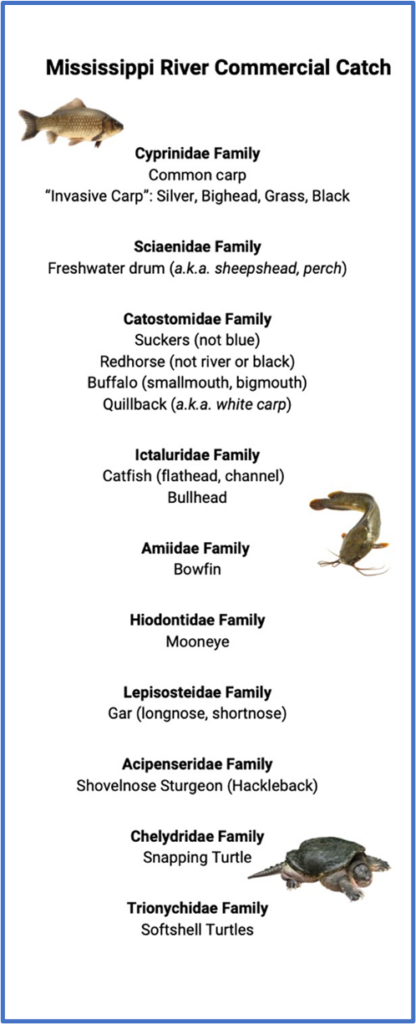 Carp, Cats, Perch and Pearls: Wisconsin’s Unsung Commercial Fishery
Carp, Cats, Perch and Pearls: Wisconsin’s Unsung Commercial Fishery
By Sharon Moen
Wisconsin Sea Grant exists because the state’s boundaries include parts of lakes Superior and Michigan, which are viewed as inland seas by the U.S. government. Commercial fishing for food happens in these waters and Sea Grant works to help these fisheries succeed. However, there is another Wisconsin boundary where commercial fishing for food occurs – the one defined by the Mississippi River. This lesser-known fishery is also within WISG’s statewide purview.
Commercial fishers of misi-ziibi (the Ojibwe word for Great River, the Mississippi) harvest an average of 3,000 tons of fish annually. This harvest makes up approximately 2% of the total inland catch in North America[1],[2]. Of the 119 species of fish swimming in the Upper Mississippi River, Wisconsin commercial fishers are permitted to harvest members of eight families of rough fish (see sidebar). Rough fish is a catch-all term for edible, non-sports species. Wisconsin commercial fishers can also harvest two types of turtles from the Mississippi.
During the summer of 2023, Wisconsin Sea Grant staff and summer scholars visited Mississippi River commercial fishermen to better understand their businesses and the fishery and to discuss ideas for amplifying seafood production across the state. Read on to learn what surprised the Sea Grant team and how Sea Grant is working to address a challenge shared by Mississippi River commercial fishers and their Great Lakes counterparts.
Surprise #1 – Common carp are truly common
Common carp, a Eurasian species intentionally introduced into North American waterways well over a century ago, dominates the Mississippi River catch (~37% of total weight)[3].
Mike Valley, owner of Valley Fish and Cheese and a fourth-generation fisher said, “I got into fishing through my father and my grandfather who were in the same business. In the smoked fish end of it, we do carp, buffalo, bullheads, catfish, sturgeon and perch. And out of all of those, the carp is the number one seller. Second probably is catfish.”
Back in 1880, Wisconsin fisheries managers and residents welcomed common carp. One might imagine them cheering when 75 of these fish were shipped from Washington, D.C., to the Nevin fish hatchery near Madison, Wisconsin. Little did they know what mayhem would ensue as the offspring of the 75 were scattered throughout the Midwest. Carp can thrive and prolifically spawn in practically all types of water. After arriving at Nevin, it took common carp less than three years to show up in the Mississippi River. [4]
There are four other non-native invasive carp that Mississippi River commercial fishers in Wisconsin are encouraged to keep: grass, sliver, black and bighead carp. These animals were introduced to the southern U.S. in the 1970s. The purpose of the intentional translocations was to manage algae, weeds and parasites in aquatic farms, canal systems and sewage treatment facilities. Echoing a host of nature horror movies and real-life disasters, they escaped into the Mississippi, pushed their range northward and established breeding populations.
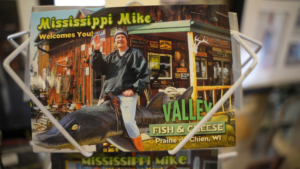
Mike Valley, owner of Valley Fish and Cheese. Photo by Bonnie Willison
Surprise #2 – Cats can be huge
Arguably, there are two families of cats commercially caught in the Big Muddy: catfish (Ictaluridae) and buffalo (Catostomidae) (see sidebar). Both are native to the system and both can reach impressive proportions.
Valley said, “When I was 16 years old, raising nets with my father, we had two catfish in one net and they each weighed 96 pounds apiece. I haven’t topped that since. You know, we got a lot of catfish in the 60s and 70s. It’s nothing to get 25 a day over 25 pounds.”
Even though catfish can be big and plentiful, their market value plunged from $4.19/kg in the 60s to $1.07/kg in the 2000s.[5] Some suggest that the decline reflects the success of U.S. catfish farming. However, other species in the Mississippi River commercial catch also indicate that demand for these fish diminished over the past 50 or so years.
Catfish have no scales. Buffalo have giant scales. Within the Great Lakes commercial fishery, the scales of lake whitefish and cisco are sometimes referred to as fish glitter. Not so for buffalo and carp, which have scales so large they look like thumbnails in the bottom of a boat. Buffalo average about 26% of the Mississippi River catch[6] and make up the bulk of Jeff Ritter’s wholesale business, Ritter Fish. Ritter is a first-generation Mississippi River fisher who works with other commercial fishers to supply food to people in Minneapolis, Chicago and similar cities.
Ritter said, “We fish for buffalo, which is our number fish. But we basically harvest all rough fish. It’s a rough fish business, which is I guess is what you would call it.”
Surprise #3 – Sheepshead can be sold as perch
The common names of fish are varied and regional. For example, Aplodinotus grunniens goes by quite a few names, such as freshwater drum, sheepshead, silver bass, thunder pumper, gaspergou and perch. Yes: commercially harvested freshwater drum can be sold as perch. This encourages its consumption, particularly in big-city markets serving ethnic neighborhoods. Don’t be fooled, though. This species is very different from the fish-fry staple yellow perch, which Ritter reports are doing quite well. As someone who can’t seem to get enough of the water, he fishes for yellow perch recreationally in Ol’ Man River.
When asked how he likes to prepare fish, Ritter said, “Basically I like to grill fish or pan fry it. My favorite here on the river is yellow perch. We have a population that has exploded in the last ten years so we have some really nice fish. A good old sheepshead, a medium-sized sheepshead when it’s grilled is really tasty, too.”
Ritter also said that they do not see many non-target species in the nets because of the Wisconsin Department of Natural Resources’ mesh size restrictions. “Over the course of a year, I might see ten game fish total. We don’t harm our resource.”
A male sheepshead makes grunting noises by rubbing muscles along its swim bladder, causing it to vibrate. Native Americans strung together the freshwater drum’s large otoliths (granules of calcium carbonate) as necklaces or bracelets. There is some indication that this fish, with its big molar-like crushing teeth, may be learning to eat zebra mussels.
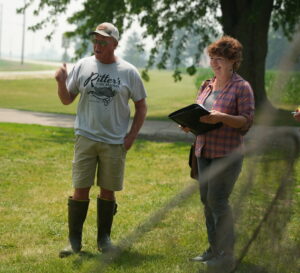
Jeff Ritter, owner of Ritter Fish, in conversation with Sharon Moen, food-fish outreach coordinator for Wisconsin Sea Grant. Photo by Jeremy Van Mill
Surprise #4 – Freshwater pearls and clam shells were big business
Once upon a time, the people of Prairie du Chien, Wisconsin,- lived in “the freshwater pearl capital of the U.S.” In these colorful years (1900-1920), clamming and button cutting was almost as important to the economy of the area as the fur trade had been.[7] A visit to Valley Fish and Cheese is also testament to this locally important industry. Artifacts from the clamming industry hang on the western exterior of Mike Valley’s processing building and, as a former clammer and adept storyteller, he is willing to share insights.
Valley remembers clamming in the 60’s, when the industry was in a revival. Then, the shells were being shipped to Japan to support the cultured pearl industry. Valley says that better pearls were being produced more quickly if the oysters were seeded with beads cut from Mississippi River clams. In the summer of 1966, 600 tons of shells were shipped out of Prairie du Chien.
Back in the day, though, buttons were the bread-and-butter of the industry. The high-value product was freshwater pearls. Freshwater pearls take on the color of their mothershells, which can range from pink to shades of blue, green and lavender. At one point, there were 27 freshwater pearl buyers in Prairie du Chien alone.[8] Summer tent cities involving entire families would line the riverbank while floating grocery stores would ply the water selling supplies.
The Wisconsin Department of Natural Resources reports 39 species of mussels (commonly called clams) found along the Wisconsin portion of the Mississippi River. Their distribution varies and some are achingly rare. Most freshwater mussels can’t go it alone. They need particular fish or salamander hosts for their parasitic young (glochidia). To wit: Only gars function as hosts to the most valuable of all freshwater mussels: the yellow sandshell. This species was used for top-grade buttons, pearl handles for knives and similar artifacts.
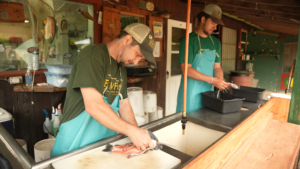
Jeremiah’s Bullfrog Fish Farm. Photo by Bonnie Willison
A common conundrum: Where’s the workforce?
“There’s room for up-and-coming fishermen,” said Ritter. “If you have a good work ethic and stick your nose to the grindstone, I think you can make a good living at it.”
Commercial fishing on the upper Mississippi peaked in the mid-1960s when the industry produced more than 6,000 tons of fish and generated about $9 million. Since that heyday, the number of commercial fishers plying the Wisconsin waters of the Mississippi has declined to a mere handful. Many are over 50 and thinking of retiring. At least one is 80.
Valley said he fishes five days a week when he has help but when Sea Grant visited, he was fishing two. “We have no problem selling our fish. The problem is making it, finding enough time and the help. That’s the number one problem, you know? I can only clean 400 to 800 pounds in a day, so that’s what I catch. I could set nets and catch two or 3,000, no problem.”
Fisheries managers agree that the Upper Mississippi River commercial fishery is stable and could support larger harvests.[9] The gear needed is unsophisticated: gill nets, trammel nets, hoop nets, and trot lines. And it is common for people to participate in the commercial fishery to supplement other incomes. So, if you know of a youngster who, like Ritter, has a penchant for playing in the mud, chasing turtles and catching bluegills, or like Valley, who simply loves being on a boat at dawn, there’s a career opportunity as a commercial fisher worth considering.
Both Ritter and Valley say that commercial fishing is in their blood. “It has been in my blood since I was a little boy,” said Ritter. “The Mississippi River is God’s country, that’s for sure. If I’m not working, I’m playing on it. I just fish.”
A new fisher will reap the benefits of a less polluted river but also one that is being increasingly used for recreation including party boats and sports fishing events. Climate change will continue to challenge the commercial fishing industry with variable water levels, flash floods, droughts, heat waves and sedimentation caused by erosion. Invasive species will continue to add to the complications.
Sea Grant’s visits with commercial fishers are generating momentum for future workforce development programs. Additionally, the exchange of information with business and rural communities is helping to build a more resilient food-fish industry and supporting the Wisconsin Idea that education should influence people’s lives beyond the boundaries of the classroom. Find some of the results of the Mississippi River interviews here:
[1] Welcomme, R.L. ( 2011), An overview of global inland fish catch statistics. ICES Journal of Marine Science 68, 1751 – 1756 .
[2] Klein, Z.B., Quist, M.C., Miranda, L.E., Marron, M.M., Steuck, M.J. and Hansen, K.A. (2018), Commercial Fisheries of the Upper Mississippi River: A Century of Sustained Harvest. Fisheries, 43: 563-574. https://doi.org/10.1002/fsh.10176
[3] Ibid.
[4] The first records of common carp caught in the Mississippi River were from Hannibal, Missouri, and Quincy, Illinois in 1883. https://www.nps.gov/miss/learn/nature/ascarp_common.htm#:~:text=German%20and%20Scandinavian%20immigrants%20brought,and%20Quincy%2C%20Illinois%20in%201883.
[5] Klein et al. (2018).
[6] Klein et al. (2018).
[7] Temte, E.F., 1968, A brief history of the clamming and pearling industry in Prairie du Chien, Wisconsin. Seminar paper presented to the faculty of the graduate school, Wisconsin State University at LaCrosse.
[8] Ibid.
[9] Johnson, B.L., and Hagerty, K.H., eds., 2008, Status and trends of selected resources in the Upper Mississippi River System: U.S. Geological Survey, Upper Midwest Environmental Sciences Center, La Crosse, Wisconsin, December 2008, Technical Report LTRMP 2008-T002, 102 p., plus 2 appendixes.
The post Carp, Cats, Perch and Pearls: Wisconsin’s Unsung Commercial Fishery first appeared on Wisconsin Sea Grant.News Releases | Wisconsin Sea Grant
News Releases | Wisconsin Sea Grant
https://www.seagrant.wisc.edu/news/carp-cats-perch-and-pearls-wisconsins-unsung-commercial-fishery/
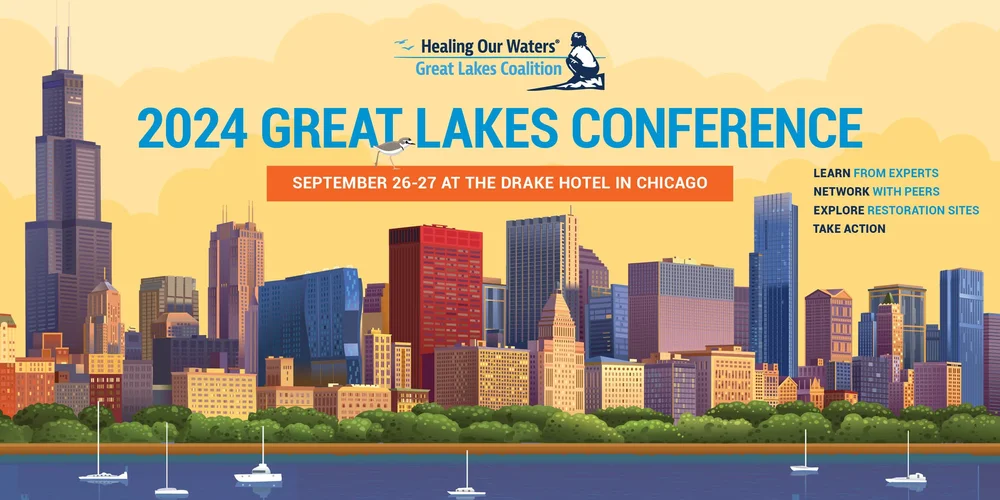
The Healing Our Waters-Great Lakes Coalition is excited to announce that the 2024 Great Lakes Conference will be held from Thursday, September 26 to Friday, September 27 in Chicago, Illinois.
We’ll be having two days of interesting breakout sessions, thought-provoking plenaries, a fabulous reception, fun field trips, and plenty of time for relationship building and networking. Advocates from across the region attend and vary from university students to policy analysts to environmental justice leaders, and everyone in between.
The Coalition invites folks to submit a proposal to lead a breakout session or host a field trip in Chicago. We are seeking proposals for these sessions from individuals and local, Tribal, state, regional, and national organizations working on issues of relevance to Great Lakes restoration.
Breakout sessions at the conference provide valuable insights, unique stories, and practical hands-on training relevant to Great Lakes advocacy and restoration. Though not an exhaustive list, potential topic areas can include: Great Lakes policy issues; innovative and compelling Great Lakes restoration stories and case studies; addressing environmental injustices; and Great Lakes research. Field trips complement conference topics, allow participants to see first-hand the important work being done by Coalition members and partners, and let participants experience the culture and unique identity of the host city.
The Coalition is dedicated to using the conference platform to highlight all voices of the Great Lakes region and strives to be inclusive of the entire Great Lakes community. We strongly encourage applications from those representing culturally and racially diverse communities, as well as groups or individuals representing or supporting work the communities most impacted by pollution throughout the Great Lakes region.
The deadline to submit proposals is May 1, 2024. Further information and application instructions can be found on our website.
For questions regarding session proposals or the conference in general, contact Sophee Langerman (LangermanS@nwf.org) or Laura Rubin (RubinL@nwf.org).
As the conference planning moves forward, we will share registration information and updates on the agenda. In the meantime, block off September 26-27 on your calendars. We hope to see you there!
Latest Updates - Healthy Lakes
Latest Updates - Healthy Lakes
https://www.healthylakes.org/latest-updates/great-lakes-conference-2024
Adding accessible ramps, boat launches, trails, and signage is helping visitors with disabilities access a culturally and environmentally significant Great Lakes destination.
The Apostle Islands National Lakeshore, known for its natural beauty and views of Lake Superior, is becoming more accessible for visitors with disabilities.
Officially designated a national lakeshore in 1970, the Apostle Islands National Lakeshore is located near Bayfield, Wisconsin, where it overlaps with a portion of the Red Cliff Reservation. The 21 publicly available Apostle Islands have deep historical and cultural significance for the Red Cliff Band of Lake Superior Chippewa and attract more than 200,000 visitors per year.
Tourists travel to the site to visit the famous sea caves, kayak in Lake Superior, explore historic lighthouses, walk along the 12-mile mainland lakeshore, and much more. However, thanks to uneven terrain and inaccessible infrastructure, not all guests have been able to fully experience the area’s natural splendor.
Federal investments to restore and protect the Great Lakes are helping ensure that everyone, including those with mobility needs, non-English speakers, and people with disabilities, can access and enjoy the myriad benefits—such as hiking, wildlife viewing, fishing, and water sports—across the region.
According to the Centers for Disease Control and Prevention, more than 12% of Americans live with mobility needs that make it difficult to do activities like climb stairs or walk on rocky beaches. At the Apostle Islands National Lakeshore, these difficulties have been exemplified at places like the popular Meyer’s Beach, where a 45-step staircase between the parking lot and the shore has prevented visitors with mobility concerns from accessing outdoor recreation opportunities at the nearby boat launch.

Accessible viewing platform up to binoculars on a dock at Little Sand Bay.
Credit: National Park Service
Since 2022, the Friends of the Apostle Islands National Lakeshore—a nonprofit organization comprised of local water recreation enthusiasts, conservationists, businesspeople, and other advisors—have been raising funds to improve accessibility to the area. At the forefront of these efforts are plans for a 500-foot Americans with Disabilities Act (ADA) accessible ramp, bilingual informational displays, audio and tactile accommodations for blind and deaf visitors, and a wheelchair-accessible overlook on the dock at Little Sand Bay.
Updates also include a network of accessible trails along the mainland lakeshore, which was previously without formal hiking and walking paths. By introducing these trails, conservationists hope to prevent habitat destruction and damage to lakeside flora from “social trails,” which are created when visitors forge their own paths through the environment.
These improvements are made possible in part by a $165,577 grant from the U.S. National Park Service via funding from the Bipartisan Infrastructure Law. Additional funding includes an in-progress $325,000 fundraiser by the Friends of the Apostle Islands. As early as this year, Park Service officials will collaborate with the Friends of the Apostle Islands and other key partners to begin work on these projects.
Continued investment in the Apostle Islands not only inspires tourism in Wisconsin, but also helps the National Park Service study, preserve, and protect a myriad of local wildlife, including deer, bears, foxes, coyotes, beavers, otters, hares, waterfowl, and more than 80 species of fish.
Resource Challenges Addressed
ADA accessibility
Environmental justice
Habitat conservation
Key Partners
U.S. National Park Service, Friends of the Apostle Islands, Wilderness Inquiry, U.S. Access Board, Wisconsin Coastal Management, and various corporate and private advisors
Cost
$490,577
Results and Accomplishments
Upcoming infrastructure improvements to the Apostle Islands National Lakeshore will increase accessibility for visitors with disabilities and help preserve local wildlife.
*This story is part of a Great Lakes restoration success story packet that was used in the Coalition’s 2024 Great Lakes Day, with one story from each state in the region. Read the full packet
Latest Updates - Healthy Lakes
Latest Updates - Healthy Lakes
https://www.healthylakes.org/latest-updates/making-the-apostle-islands-more-accessible-for-visitors-with-disabilities
Restoring the natural flow of Nanticoke Creek and removing old dams and culverts will help prevent further acid mine drainage, erosion, flooding, and waterway pollution.
After generations of a thriving coal economy, Pennsylvania is now home to approximately 5,000 abandoned underground mines, making up one third of the abandoned mine lands in the country. These mines—which often produce a form of water pollution known as acid mine drainage—release toxic metals, contaminants, and methane gas into the environment and pose serious health risks for humans and wildlife.
While acid mine drainage is not as common in the Great Lakes Basin as other forms of pollution and environmental harm, it is important to recognize the different threats to local waters and how they impact drinking water, public health, and quality of life. One of the principles of Great Lakes restoration and protection is the need to tackle—in a comprehensive way—all of the issues impacting the waters that people and wildlife rely on.
Acid mine drainage is the leading source of water pollution in Pennsylvania and occurs when water makes its way through underground mine systems, where it meets with heavy metals and becomes acidic. When this polluted water flows into connected waterways, it introduces toxic metals like lead and mercury into drinking water, damages the soil, harms the growth of plants, and erodes infrastructure like roads and bridges.

An acid mine drainage treatment system on Nanticoke Creek.
Credit: Pennsylvania Department of Environmental Protection
For Pennsylvania’s Susquehanna River Basin, which spans almost half the land area of the state, acid mine drainage is a primary concern. Today, only 30% of streams in the basin demonstrate the natural hydrological and ecological qualities of a stream, and some have been declared “biologically dead,” meaning they are unable to support aquatic life. Restoration of these streams is a major step toward improving public and environmental health outcomes across the state.
Thanks to federal funding, nonprofit organization Earth Conservancy is undertaking a major restoration process for Nanticoke Creek, a 4.5-mile tributary of the Susquehanna River in Luzerne County. The project will help prevent further acid mine drainage to the Susquehanna River Basin by restoring the creek’s historic alignment and preventing water from flowing into nearby abandoned mines.
To accomplish this, conservationists plan to reconnect the Nanticoke Creek headwaters in the upper part of the stream, allowing water to resume its natural flow. The project will also remove or replace outdated infrastructure like culverts, dams, and bridges to increase the water capacity of the tributary and reduce the risk of erosion and flooding.
In October 2023, Earth Conservancy was awarded $17.5 million in federal grant monies for the restoration of Nanticoke Creek. The funding was awarded by the Pennsylvania Department of Environmental Protection’s Abandoned Mine Lands and Acid Mine Drainage Grant Program and was made possible by the Bipartisan Infrastructure Law, which allocated $240 million to the state of Pennsylvania for clean water projects. Along with a $1,956,427 Brownfields Cleanup grant awarded last June by the U.S. Environmental Protection Agency, Earth Conservancy will use this funding to complete 15,000 linear feet of improvements in the Nanticoke Creek restoration plan.
Resource Challenges Addressed
Water pollution
Acid mine drainage
Public health
Flooding
Habitat restoration
Key Partners
Earth Conservancy, the Pennsylvania Department of Environmental Protection, and the U.S. Environmental Protection Agency
Cost
$19,456,427
Results and Accomplishments
The restoration of Nanticoke Creek will restore 15,000 linear feet of Nanticoke Creek, reducing acid mine drainage, flooding, and erosion.
*This story is part of a Great Lakes restoration success story packet that was used in the Coalition’s 2024 Great Lakes Day, with one story from each state in the region. Read the full packet
Latest Updates - Healthy Lakes
Latest Updates - Healthy Lakes
https://www.healthylakes.org/latest-updates/reducing-water-pollution-caused-by-acid-mine-drainage
Replacing lead water service pipes in Cuyahoga County, Ohio, will reduce the risk of toxic lead exposure for children and adults.
Seventy years after Cleveland, Ohio, stopped installing leadbased water service lines in homes, its Division of Water is still hard at work replacing the county’s approximately 178,000 remaining lead lines with copper. Although the Division of Water has routinely replaced between 2,000 and 3,000 lead pipes per year, its number of lead pipes still rank among the highest in the country. At the current rate of replacement, it will take decades to ensure all 1.4 million people in the Cuyahoga County service area have safe, lead-free service lines.
Replacing lead service lines is an important public health issue. According to the U.S. Environmental Protection Agency (EPA) and the Centers for Disease Control and Prevention, the presence of lead in drinking water can cause severe negative health effects for adults, children, and fetuses. Adults who consume lead in drinking water may experience symptoms like high blood pressure, a decline in cardiovascular health, increased risk of hypertension, decreased kidney function, and reproductive issues. In pregnant people, lead exposure can result in premature birth and small, undernourished babies. Children may experience anemia, hearing problems, behavioral and learning delays, and, in severe cases, seizures, coma, and death.
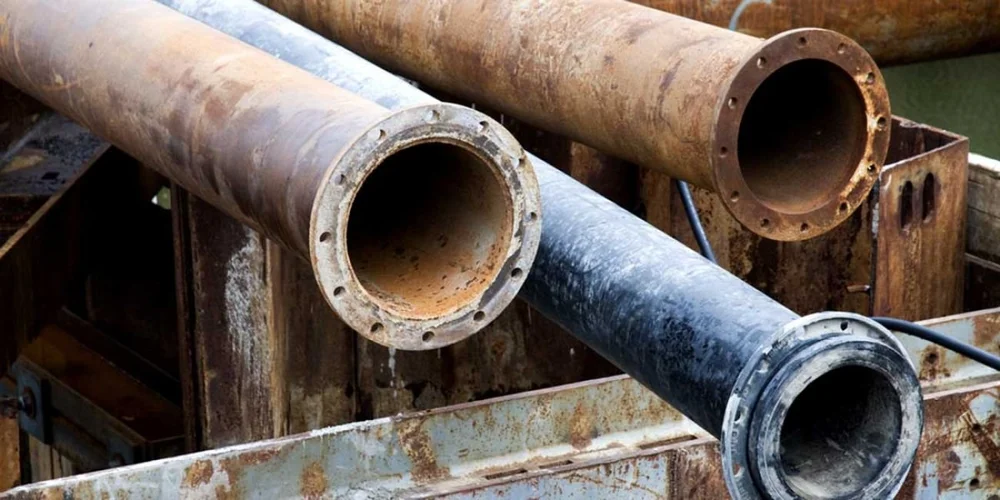
Lead pipes that have been removed from a water system
Cleveland Water has been consistently treating the city’s drinking water for lead since 1997, and no new lead-based lines have been installed since 1954, but the utility still says that replacing existing lead lines with non-toxic copper is the safest course of action for Cleveland residents.
To that end, the City has been ramping up its lead pipe replacement efforts since 2021, when it launched a $2.5 million pilot program funded by state and federal dollars to replace lead service lines to more than 450 daycare centers in Cleveland.
From there, the city received $19 million in federal funding from the Ohio EPA, which allowed Cleveland Water to replace more than 4,000 pipes in 2023. The city plans to apply for additional funding, made available as part of $355 million awarded to the Ohio EPA via the federal Bipartisan Infrastructure Law, in similar amounts each year for the next four years.
This support will allow Cleveland to replace 4,000– 6,000 lines annually, with total replacement of all lead service lines expected to be completed in 25 years. Initial work is centered on 13 communities that have been identified as “disadvantaged,” according to guidelines set by the federal government that assess communities based on rates of poverty, unemployment, water affordability, and other factors. Out of the 78 total communities in the Cleveland Water service area, these 13 communities are home to 80% of the lead service lines.
Resource Challenges Addressed
Lead poisoning
Water quality
Water pollution
Water infrastructure
Environmental justice
Key Partners
Ohio Environmental Protection Agency, City of Cleveland Division of Water, U.S. Environmental Protection Agency, and the U.S. Department of Labor
Cost
$19,000,000
Results and Accomplishments
Cleveland Water was able to replace more than 4,000 lead pipes in 2023. Future funding from the Bipartisan Infrastructure Law will enable the city to continue this progress, removing lead water pipes from 13 disadvantaged Cleveland communities and eliminating 80% of the remaining lead service lines in the city, resulting in better health outcomes for residents of Cuyahoga County
*This story is part of a Great Lakes restoration success story packet that was used in the Coalition’s 2024 Great Lakes Day, with one story from each state in the region. Read the full packet
Latest Updates - Healthy Lakes
Latest Updates - Healthy Lakes
https://www.healthylakes.org/latest-updates/removing-lead-water-pipes-in-communities-to-protect-public-health
Planning grant sets the stage for revitalizing one of most polluted bodies of water in New York by restoring wetlands, protecting native species, and reducing pollutants into Lakes Erie and Ontario.
Thanks to federal funding, conservationists near Buffalo, New York, are making strides toward major revitalization efforts for Scajaquada Creek, a 13-mile, spring-fed stream that has a significant impact on the health of both humans and wildlife in Erie County and beyond.
Scajaquada Creek, which is considered one of the most polluted bodies of water in the state by the Environmental Protection Agency, flows through a portion of the Erie Canal before emptying into the Niagara River, which in turn connects Lake Erie to Lake Ontario. The stream has been a source of concern for water conservation organization Buffalo Niagara Waterkeeper for more than 30 years.
Currently, the stream is heavily polluted by sewage overflow and industrial waste from nearby brownfields (land that is abandoned or underutilized due to pollution from industrial use). Stormwater and sediment runoff contribute to this pollution, which in some areas has resulted in contaminated mud and soil up to five feet deep. As of 2023, Scajaquada Creek contained 20 times more fecal bacteria than is considered safe for human contact and was identified as a breeding ground for avian botulism, a disease that is estimated to have killed thousands of birds in the area.
Initial steps toward revitalization will involve restoring the stream’s natural pathways by addressing issues caused by poor infrastructure, such as straightened channels, hardened shorelines, and buried sections of the stream. Through returning the natural flow of water, conservationists hope to restore at least some of the area’s historic wetlands, 98% of which have been destroyed. Wetlands are important habitats that help filter water and provide homes to countless fish and wildlife species.

Part of a flood risk management feasibility study within the Scajaquada Creek watershed.
Credit: Buffalo Niagara Waterkeeper
These restoration efforts will also protect and increase native plant species, address the sewage and industrial pollution problems, and clean up contaminated soil. These improvements will lead to better public health outcomes, not only for the approximately 100,000 people in Buffalo, Cheektowaga, Depew, and Lancaster who rely on the 29-square-mile Scajaquada Creek watershed, but also residents of other interconnected watersheds around Lakes Erie and Ontario.
To fund these projects, Buffalo Niagara Waterkeeper was awarded $900,000 by the National Oceanic and Atmospheric Administration’s Climate-Ready Coasts initiative. A portion of the funding, which was made available by the Bipartisan Infrastructure Law and the Inflation Reduction Act, will go toward a $600,000 feasibility study that will outline next steps for the restoration process.
The feasibility study was initiated in July 2023 by Buffalo Niagara Waterkeeper and the U.S. Army Corps of Engineers Buffalo District and is being funded by these federal dollars and $250,000 in partner matching from the Margaret L. Wendt Foundation and the Ralph C. Wilson Jr. Foundation in western New York.
The study will focus on the portion of the stream that flows through Cheektowaga and is expected to take two years to complete. Upon its completion, the Scajaquada Creek project will become eligible for up to $10 million in federal funds for continuing restoration efforts.
Resource Challenges Addressed
Water pollution
Habitat loss
Wetland degradation
Sewage and industrial waste overflow
Native species conservation
Sediment and stormwater runoff
Key Partners
Buffalo Niagara Waterkeeper, U.S. Army Corps of Engineers Buffalo District, Margaret L. Wendt Foundation, Ralph C. Wilson Jr. Foundation, and New York State Department of Environmental Conservation
Cost
$900,000
Results and Accomplishments
Between now and 2025, a two-year feasibility study will pave the way for major restoration efforts to western New York waterways and wetlands.
*This story is part of a Great Lakes restoration success story packet that was used in the Coalition’s 2024 Great Lakes Day, with one story from each state in the region. Read the full packet
Latest Updates - Healthy Lakes
Latest Updates - Healthy Lakes
https://www.healthylakes.org/latest-updates/cleaning-up-the-scajaquada-creek-watershed
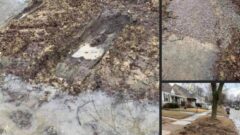
By Kelly House, Bridge Michigan
The Great Lakes News Collaborative includes Bridge Michigan; Circle of Blue; Great Lakes Now at Detroit Public Television; Michigan Public, Michigan’s NPR News Leader; and The Narwhal who work together to bring audiences news and information about the impact of climate change, pollution, and aging infrastructure on the Great Lakes and drinking water.
Great Lakes Now
https://www.greatlakesnow.org/2024/03/judge-holds-flint-in-contempt-continued-lead-pipe-replacement-delays/
The Village of Skokie, Illinois, is planting at least 450 trees by 2028, reducing heat islands and improving health outcomes for its 68,000 residents.
Located 16 miles north of downtown Chicago, the Village of Skokie, Illinois, has committed to increasing its tree coverage from 25.5% to 31% by 2040.
The Village will start by planting 450 free trees over the next five years. Eligible locations for plantings include schools, apartment buildings, condominiums, businesses, and places of worship. For each tree planted, Skokie officials will match the investment with an additional tree on a Village-owned parkway or right-of-way, with the goal of 1,065 new trees.
Increasing tree canopies in urban areas provides numerous health benefits for people and the environment. Studies have shown that the presence of trees leads to better physical and mental health outcomes for people by reducing the risk of respiratory and heart disease, easing stress, and increasing overall life expectancy. A greater concentration of trees has also been linked to reducing childhood obesity by as much as 12%.
By creating shade, trees help remove “heat islands,” exposed areas that experience more extreme temperatures due to a lack of tree cover and prevalence of materials like concrete, asphalt, and glass. This shade provides opportunities for people and wildlife to stay cool and reduces the energy it takes to air condition buildings. Trees also absorb airborne pollutants and carbon dioxide, soak up stormwater, and help prevent flooding. Investing in nature-based solutions—trees, wetlands, forests and rain gardens—is an important strategy for communities to improve the health of their local waters and ultimately the Great Lakes.
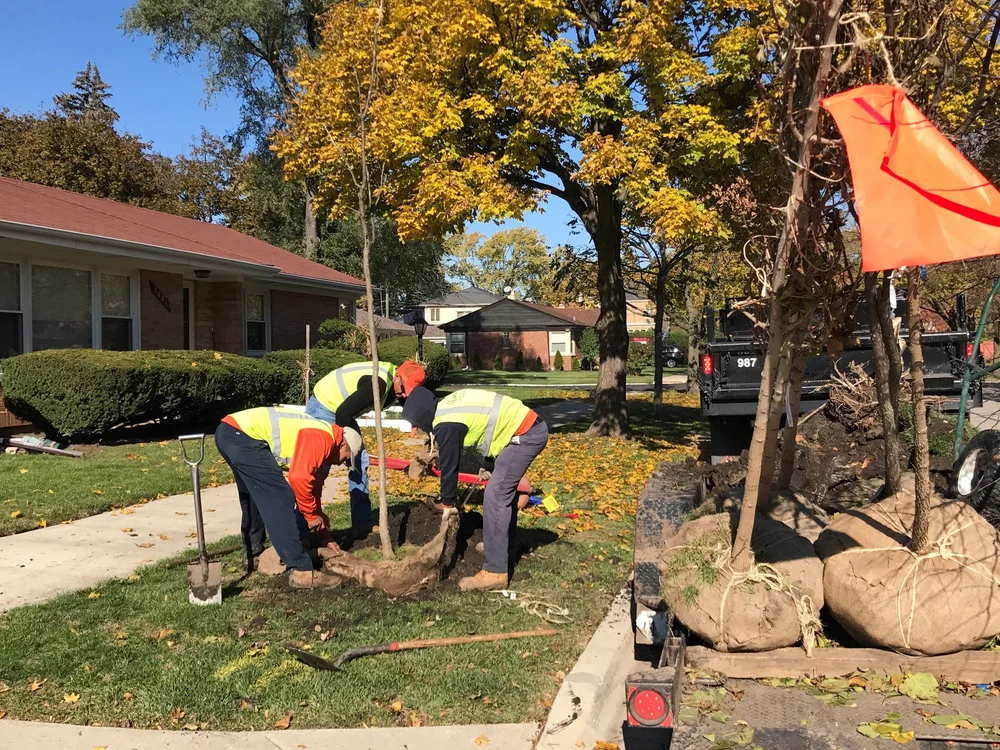
Workers planting trees in a Skokie neighborhood.
Credit: Village of Skokie
These strategies are increasingly important to help communities prepare for the impacts of climate change. Skokie’s tree-planting project stems from the city’s environmental sustainability plan, which looked at climate impacts through 2050 and found that many low-income neighborhoods and neighborhoods with higher proportions of People of Color lacked tree canopy coverage compared with more affluent neighborhoods.
Village officials chose to prioritize planting trees in disadvantaged areas and consulted the federal government’s Climate and Economic Justice Screening Tool (CEJST) to determine which neighborhoods were the best candidates. The online CEJST database uses U.S. Census data to identify areas across the country that face greater economic, environmental, and sociopolitical burdens.
In 2024, a partnership between the Village of Skokie Beautification & Improvement Commission and the Skokie Chamber of Commerce will begin surveying potential planting locations in these neighborhoods and beyond.
This project is made possible by a $327,000 grant from the Urban and Community Forestry Program, an initiative of the United States Forest Service that awarded nearly $68 million to projects in the Great Lakes region last year. In 2023, the Forest Service received more than $1.1 billion from the Inflation Reduction Act to award to urban communities for forestry projects nationwide.
Resource Challenges Addressed
Tracking of fish contamination
Air pollution
Heat islands
Stormwater runoff
Environmental justice
Mental and physical health
Key Partners
United States Department of Agriculture Forest Service Urban and Community Forestry Program, Village of Skokie Beautification & Improvement Commission, and Skokie Chamber of Commerce
Cost
$327,000
Results and Accomplishments
By planting trees in disadvantaged neighborhoods, the Village of Skokie will combat heat islands, mitigate pollution, and improve the mental and physical health of residents.
*This story is part of a Great Lakes restoration success story packet that was used in the Coalition’s 2024 Great Lakes Day, with one story from each state in the region. Read the full packet
Latest Updates - Healthy Lakes
Latest Updates - Healthy Lakes
https://www.healthylakes.org/latest-updates/combating-heat-islands-in-disadvantaged-neighborhoods
Improvements to the downtown Lakewalk in Duluth, Minnesota, are increasing climate resiliency, public safety, and accessibility, along the Lake Superior coastline.
In 2017 and 2018, three major storms along the banks of Lake Superior caused more than $30 million in damage to the waterfront Lakewalk in Duluth, Minnesota.
The Lakewalk—which offers access to downtown tourist districts, beaches, historic sites, and views of the lake—was built in 1986 and expanded over the course of the last 38 years to encompass nearly eight miles of paved, multi-modal pathways for bikers, skateboarders, pedestrians, and anyone else interested in exploring the natural beauty of the coast.
The trail has become a popular destination for activities like birdwatching, hiking, picnicking, concertgoing, and shopping for both locals and the city’s more than 6 million annual tourists. However, as climate change has resulted in more frequent severe storm events, the Lakewalk’s proximity to Lake Superior has paved the way for continued infrastructure challenges.

Duluth Lakewalk.
Credit: Friends of the Lakewalk
The 2017 and 2018 storms, which were considered state and federal disasters, eroded parts of the shoreline and displaced large boulders that had protected the lakefront from Lake Superior for more than 30 years. After months of costly repairs and concerns about future storm events, city officials consulted with local, state, and federal partners to develop the Lakewalk Transportation and Resiliency Improvement project, which seeks to rehabilitate damaged portions of the trail and fortify the Lakewalk against climate change. Preparing communities for the impacts of climate change, like flooding, not only protects local infrastructure, homes, businesses, and outdoor trails, but in the long run, it also protects Great Lakes water quality and fish and wildlife habitat.
One aspect of the project is enhancing existing revetments that separate the Lakewalk from the water. Revetments are built with impact-resistant material, such as concrete or boulders next to shoreline banks or walls to absorb the impact of incoming water to prevent erosion. Boulders that were displaced during previous storms will be replaced by heavier rocks weighing up to nine tons, with the hope that increasing the size and efficacy of these barriers will help prevent storm damage to nearby homes and businesses.
These improvements will also protect other important infrastructure, like parts of Interstate 35, service lines for the Western Lake Superior Sanitary District, and portions of commercial railroad tracks.
Additional renovations to improve the trail’s accessibility in accordance with the Americans with Disabilities Act are also underway, such as paving areas with rough terrain to make the Lakewalk fully wheelchair accessible for the first time. Other goals include adding more trail connections to nearby districts and neighborhoods, creating a designated bike lane, and implementing eight new rest areas.
To fund this project, the City of Duluth was awarded an $8,196,234 Rebuilding American Infrastructure with Sustainability and Equity (RAISE) grant by the U.S. Department of Transportation in 2023. The RAISE grant, one of 162 awarded last year, was made possible by federal funding from the Bipartisan Infrastructure Law (BIL). An additional $2 million in BIL funding from the Minnesota Department of Transportation and $2 million from the City of Duluth will also be invested in the project.
Resource Challenges Addressed
Coastal resiliency
Erosion
Public transportation
Economic growth
Americans with Disabilities Act accessibility measures
Storm event management
Shoreline restoration
Key Partners
U.S. Department of Transportation, City of Duluth Parks & Recreation, Minnesota Department of Transportation, and local organizations and businesses
Cost
$12,250,000
Results and Accomplishments
Renovations to the Duluth Lakewalk will help protect against increased storm events due to climate change, safeguard local homes and businesses, and provide more ADA accessible opportunities for outdoor recreation.
*This story is part of a Great Lakes restoration success story packet that was used in the Coalition’s 2024 Great Lakes Day, with one story from each state in the region. Read the full packet
Latest Updates - Healthy Lakes
Latest Updates - Healthy Lakes
https://www.healthylakes.org/latest-updates/protecting-the-lake-superior-coastline-from-severe-storm-events
NCEI News Feed
https://www.ncei.noaa.gov/news/global-climate-202402
Upgrading wastewater infrastructure in Lansing, Michigan, is preventing millions of gallons of sewage from overflowing into local waterways, protecting water quality, and improving public health.
Between 2020 and 2035, Lansing, Michigan, will invest an estimated $250 million into separating its outdated and leaky combined sewer overflow system to meet federal requirements and prevent millions of gallons of untreated sewage from entering the watershed each year.
Combined sewer overflow systems are designed to prevent flooding during rain and snow events by collecting overflow from sewage systems and storm drains and delivering it via a single overflow pipe to a nearby water treatment plant. In 2019, the Environmental Protection Agency reported that combined sewer overflows are a “priority water pollution concern” for 860 U.S. municipalities, many of which are located in the Great Lakes region.
Lansing’s combined sewer overflow system is notoriously leaky. Intense rain can overwhelm the system, spewing sewage into the nearby Grand River—the longest river in Michigan— and one of its tributaries, the Red Cedar River. From there, the contaminated water drains into Lake Michigan.
In 2020, Lansing’s combined sewer overflow system delivered more than 333 million gallons of sewage-contaminated water to the Grand River. The system is easily overburdened by even relatively small rain or snow events, and in some recent years has produced more sewer overflow than any other city in the state. In 2019, for example, a rain event that produced approximately half an inch of precipitation resulted in more than 4 million gallons of polluted overflow.

Pipe part of a combined sewer overflow system in Lansing.
Because of overflow events like these, the Grand and Red Cedar rivers have been designated “impaired” by the Michigan Department of the Environment, Great Lakes, and Energy (EGLE) and are at times considered unsafe for human contact due to the presence of bacteria like E. coli.
Overflow incidents like these also put fish and wildlife populations at risk by overburdening the waterways with nutrients like carbon, phosphorous, and nitrogen, which use up too much of the oxygen in the water and can result in fish kills.
In 2022, the city received $6,500,000 through the Bipartisan Infrastructure Law via Michigan’s Clean Water State Revolving Fund, an investment that will help Lansing meet federal clean water regulations. The grant also has the potential to help ease the financial burden placed on the city’s 78,500 residents, who are expected to pay 4% more per year on their sewage utility bills for the duration of the project; this increase would be higher without these additional funds from the Bipartisan Infrastructure Law.
Once completed, the elimination of the combined sewer overflow system will revitalize hundreds of miles of Michigan sewers, help safeguard more than 154 species of fish, and make the Grand and Red Cedar rivers safer for water recreation.
Resource Challenges Addressed
Public health and safety
Water quality
Water pollution
Water infrastructure
Key Partners
City of Lansing, Michigan; EPA; Lansing Board of Water and Light; Michigan Department of Environment, Great Lakes, and Energy
Cost
$250,000,000
Results and Accomplishments
Renovating Lansing, Michigan’s combined sewer overflow system is preventing millions of gallons of untreated sewage from contaminating local waters and Lake Michigan, thereby protecting public health, safeguarding fish wildlife populations, and increasing recreation opportunities.
*This story is part of a Great Lakes restoration success story packet that was used in the Coalition’s 2024 Great Lakes Day, with one story from each state in the region. Read the full packet
Latest Updates - Healthy Lakes
Latest Updates - Healthy Lakes
https://www.healthylakes.org/latest-updates/preventing-combined-sewer-overflow-to-lake-michigan
Removing an unsafe low-head dam in Indiana’s Mississinewa river leads to increased fish habitat, safer recreation, improved water quality, and increased flood prevention.
By removing the Charles Mill Dam on the Mississinewa River in November 2023, the City of Marion, Indiana, reconnected nearly 1,000 miles of waterways, improved public safety, and restored vital migration routes for local fish and wildlife species.
Built in 1936, the Charles Mill Dam was a low-head dam adjacent to the historic Charles Mill grist mill, along the banks of the Mississinewa River in Marion. Low-head dams, which serve no purpose in reducing flood risk, are known to create underwater, recirculating currents that can trap and kill unsuspecting swimmers, making them deceptively dangerous for public safety.
In 2016, the Indiana Department of Natural Resources conducted an inspection of the dam and found it to be “extremely dangerous and in poor condition,” according to a feasibility report released by the City of Marion prior to the demolition process. In the late 2010s, the Charles Mill Dam was the site of several deaths and near drownings, primarily involving children and young adults.
Low-head dams also pose significant risks for the long-term populations of fish, which rely on connected networks of streams and rivers to migrate. When fish are prevented from migrating by fish passage barriers like dams and culverts, they may be unable to access their spawning habitats, which can result in population decline.
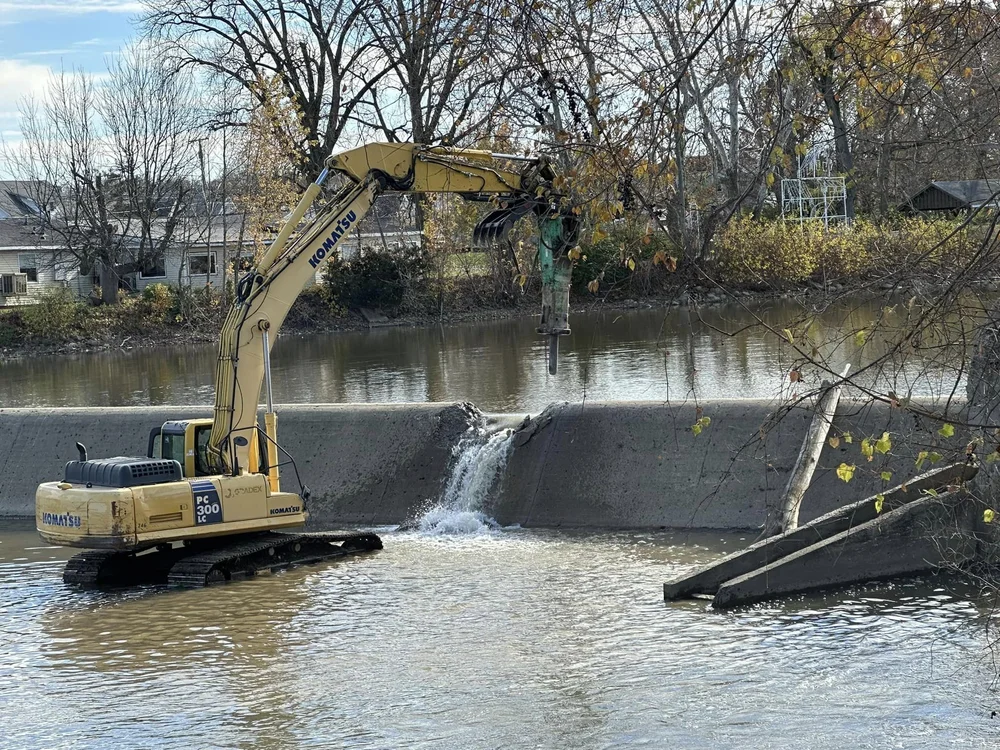
Heavy equipment breaking down the Charles Mill Dam.
Credit: EcoSystems Connections Institute, LLC
The Mississinewa River, which spans 100 miles across Indiana and Ohio, is home to more than 70 species of fish, with an estimated 85% of those species migrating upstream. Prior to demolition, the position of the Charles Mill Dam created a barrier that prevented access to 965 miles of connected waterways for species like large- and smallmouth bass, catfish, bluegill, and carp.
The dam removal project was completed in partnership with the U.S. Fish and Wildlife Service via its National Fish Passage Program, which removes barriers like these across the country to increase fish migration and spawning opportunities. Removal of the Charles Mill Dam resulted in the largest network of waterways opened by a fish passage project in the state of Indiana.
The National Fish Passage Program is funded in part by the federal Bipartisan Infrastructure Law, which granted $455 million to the U.S. Fish and Wildlife Service. Of those funds, $200 million were allocated for distribution to the National Fish Passage Program over a five-year period. The Charles Mill Dam project was awarded $325,000, with an additional $235,000 in partner matching.
Financial contributions from the Bipartisan Infrastructure Law have allowed the National Fish Passage Program to triple its resources for fish passage projects nationally, including 10 projects in the state of Indiana. Currently, similar projects in the Hoosier state are underway in Fort Wayne, Anderson, Richmond, Edinburgh, and Terre Haute.
Resource Challenges Addressed
Removing barriers to fish migration
Safeguarding fish populations
Reconnecting and revitalizing local waterways
Protecting public safety
Improving outdoor recreation
Key Partners
U.S. Fish and Wildlife Service, Indiana Department of Natural Resources, Indiana Department of Environmental Management, Ecosystems Connections Institute, Christopher B. Burke Engineering, and the City of Marion, Indiana
Cost
$560,000
Results and Accomplishments
The removal of the Charles Mill Dam will allow more than 70 species of fish to access valuable spawning grounds across 965 miles of reconnected waterways.
*This story is part of a Great Lakes restoration success story packet that was used in the Coalition’s 2024 Great Lakes Day, with one story from each state in the region. Read the full packet
Latest Updates - Healthy Lakes
Latest Updates - Healthy Lakes
https://www.healthylakes.org/latest-updates/restoring-fish-migration-pathways-in-indianas-mississinewa-river
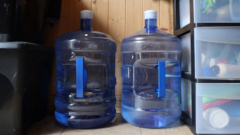
This article, first posted here, was republished with permission from Wisconsin Watch.
By Bennet Goldstein, Wisconsin Watch
Last week, a divided Wisconsin Court of Appeals upheld a lower court ruling that limited the Wisconsin Department of Natural Resources’ ability to regulate PFAS and other emerging contaminants under the state’s long-standing spills law.
Great Lakes Now
https://www.greatlakesnow.org/2024/03/efforts-to-thwart-regulation-of-pfas-polluters-move-down-parallel-tracks/
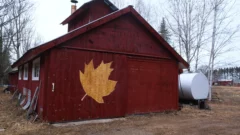
By Katie Thoresen, WXPR
This story was originally published by WXPR. WXPR is a community-licensed public radio station serving north central Wisconsin and adjacent areas of Michigan’s Upper Peninsula. Listen to their stories here.
Bright blue tubes web between the trees that run to the little red pump house that sits in the woods on the edge of 10 acres full of maple trees at Whataview Farm in Phelps.
Great Lakes Now
https://www.greatlakesnow.org/2024/03/the-northwoods-is-now-a-month-into-unusually-early-maple-tapping-season/
The warmer weather and open water is calling! When you’re out doing your favorite activities this spring and summer, you could be helping protect your lakes and rivers! Learn about some of the volunteer opportunities at Fox-Wolf below. Our volunteer opportunities give you the flexibility to do what you love while protecting your waters!
Join community members in helping improve boat launches ! Interested individuals will adopt a local boat launch and help remove plants from the launch area, pick up litter, and report issues with the launch. Volunteers also help protect our lakes by searching for aquatic invasive species at their launch! Adopt-a-Launch program is a Fox-Wolf program that works to engage community members in taking ownership of their lakes by helping to search for aquatic invasive species and improve 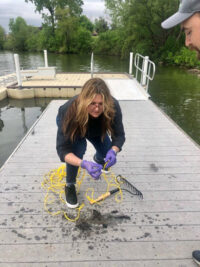 boat launches! Get involved today!
boat launches! Get involved today!
Love to paddle, kayak, or canoe in rivers and streams? Help look for invasive species during this relaxing pastime! You will be trained on how to easily identify aquatic invasive species, some native look-a-likes, and how you can keep an eye out for them when you’re floating just around the riverbend!
Join 1000+citizen volunteers statewide to collect high quality data on the lakes that you love! CLMN volunteers help monitor their lakes for a variety of things including water quality parameters, ice on/off, and aquatic invasive species! Volunteers help determine 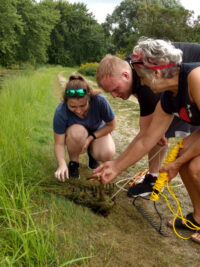 which topics they are interested in monitoring. The information gathered by volunteers is even used by Wisconsin Department of Natural Resources and university biologists and researchers, UW-Extension, and other interested individuals in projects that work to improve your lake! Help keep track of changes in your lake while being near your favorite Winnebago lake! This opportunity is easy to do from both the shoreline as well as your boat!
which topics they are interested in monitoring. The information gathered by volunteers is even used by Wisconsin Department of Natural Resources and university biologists and researchers, UW-Extension, and other interested individuals in projects that work to improve your lake! Help keep track of changes in your lake while being near your favorite Winnebago lake! This opportunity is easy to do from both the shoreline as well as your boat!
Love to garden! This one’s for you! Help control harmful invasive species in our community! The invasive plant Purple loosestrife can quickly dominate a wetland and harm our native plants. You can help by raising a natural predator of Purple loosestrife (Galerucella beetles) on caged, potted, loosestrife plants in your backyard. Once released into local infested wetlands, the beetles only eat purple loosestrife, giving native plants a chance to re-establish. This DNR program, locally coordinated by Fox-Wolf Watershed Alliance, offers free supplies and does not require previous experience. Access to an outdoor space within reach of a garden hose is ideal, but we are also looking for volunteers to help with plant potting and beetle release events.
Love talking with people? Get involved in the effort to protect Wisconsin lakes and rivers by stopping the spread of aquatic invasive species. As a volunteer watercraft inspector, you will take up the front line by conducting boater education at boat landings in your community. Inspectors perform boat and trailer checks for aquatic invasive species, educate boaters on how to stop the spread, and collect and report new infestations. Meet other anglers and boaters from across the Midwest!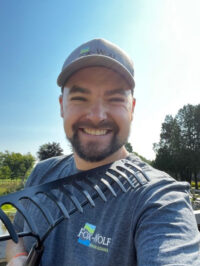
Want a single day event that’s fun for the whole family? During the statewide Aquatic Invasive Species Snapshot Day, join other water quality enthusiasts in searching for invasive species that harm our waterways. Learn how to search for invasive species that may affect the waters that are special to you. You can choose to search from the shore with binoculars and a rake or wade into friendly waters to get a better look! This event is fun for the whole family and really makes a difference in the fight against invasive species. AIS Snapshot Day occurs on August 10th, 2024.
Give the greatest gift this year to your waters; your time! Whether you want a single day opportunity or want to help out throughout the summer, we will help you fuel your environmental passions at Fox-Wolf! View more of Fox-Wolf’s volunteer opportunities by visiting: https://fwwa.org/join-us/volunteer-with-fwwa/
Interested? Contact – Chris Acy, Fox-Wolf Watershed Alliance AIS Coordinator. chris@fwwa.org. (920) 460-3674
Photo Credit: Dan O’Connell, Chris Acy
Questions? Comments? Contact Chris Acy, the AIS Coordinator covering Brown, Outagamie, Fond du Lac, Calumet, and Winnebago Counties at (920) 460-3674 or chris@fwwa.org!
Follow the Fox Wolf Watershed Alliance’s Winnebago Waterways Program on our Winnebago Waterways Facebook page or @WinnWaterways on Twitter! You can also sign-up for email updates at WinnebagoWaterways.org.
Winnebago Waterways is a Fox-Wolf Watershed Alliance program. The Fox-Wolf Watershed Alliance is an independent nonprofit organization that identifies and advocates effective policies and actions that protect, restore, and sustain water resources in the Fox-Wolf River Basin.
Check out the Keepers of the Fox Program at https://fwwa.org/watershed-recovery/lower-fox-recovery/
Reporting invasive species is a first step in containing their spread. Maintaining and restoring our waters and landscapes can reduce the impacts even when we don’t have other management options to an invasive species.
The post Warming Weather? Help Volunteer to Protect Your Favorite Places appeared first on Fox-Wolf Watershed Alliance.
Fox-Wolf Watershed Alliance
https://fwwa.org/2024/03/13/warming-weather-help-volunteer-to-protect-your-favorite-places/?utm_source=rss&utm_medium=rss&utm_campaign=warming-weather-help-volunteer-to-protect-your-favorite-places
Barring a late season snowstorm, the state of Michigan expects to use 175,000 tons less salt than usual which would save the state about $10 million. While applying salt reduces the risk of winter collisions, the briny runoff seeps into the soil and harms plants, or trickles into underground aquifers, rivers and lakes, polluting the water. Read the full story by Bridge Michigan.
Great Lakes Commission
https://www.glc.org/dailynews/20240313-salt-reduction